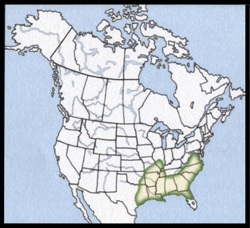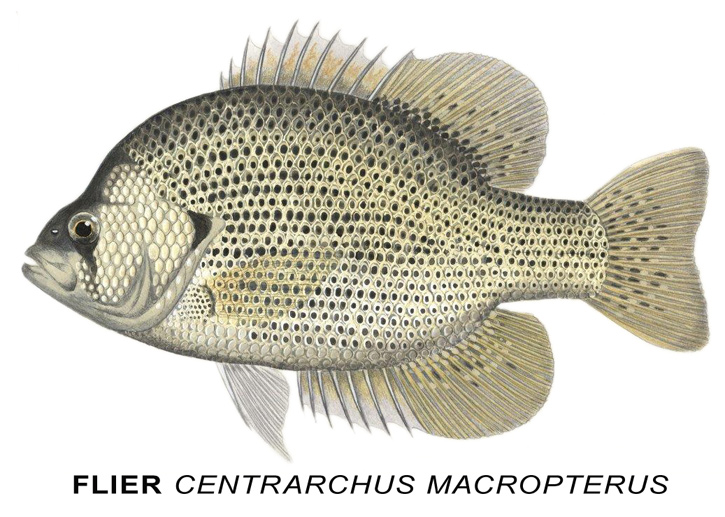Flier, June 2014, Fish of the Month!
A Brief Note to Our Readers:
A brief note about this family of Fishes: The Sunfish family includes a large number of very North American species. We're including many of them here (in spite of their often small size) because they make excellent warm-water training species for young anglers and because adult warm-water fly-fishers are likely to often take them as incidental catches and would like to know what species they've brought to hand.
Flier
Centrarchus macropterus
Local Names:
Round sunfish
Average Size:
5 to 7 inches
Distinguishing Field Marks:
(See the illustration.)
-
A very deep body covered with light colored scales with dark centers.
-
The head is moderately large with a large dark-colored eye. There is a dark nearly vertical band below the eye.
-
The mouth is moderately large with the upper jaw extending back to the mid-point of the eye.
The first and second dorsal fins are joined with no apparent separating notch.
The anal fin is very long-based, with 7 spines graduating to the same length as its soft-rayed rear section.
North American Range:
Map to the right shows approximate range in North America.
Diet:
The newly hatched young take a diet of plankton, which, as they grow, becomes based on aquatic crustaceans, and later includes a broader range of invertebrates such as snails, leeches, and small fishes, especially minnows.
Biology:
The Flier, which is often mature at 1 year of age, spawns in spring, beginning in March when the water temperature is from 62 to 68 degrees F. Spawning is typical of our Sunfishes, with the males clearing and jealously guarding the nest, eggs, and new-born. To insure a healthy gene pool, female Fliers spawn with several males in different nests, releasing from 20,000 to 35,000 eggs during active mating. At the completion of spawning, the females leave the nesting grounds and the males remain to fan the incubating eggs and guard the young when they have hatched.
The species has an average 5 year life span.
Fly Fishing for Flier:
A southern U.S. species, the Flier is most often found in clear acidic boggy habitats with ample bottom and surface structure such as stumps, weed beds, and mats of vegetation.
To match their typically diminutive size, we suggest nothing heavier than a 3 or 4 weight outfit. A wide variety of artificial flies will entice the these fish to strike, so the choice is yours. Of course, small top water foam bodied flies will provide excellent sport. For their size, Fliers are very game fighters as they powerfully struggle to reach the nearest protective shelter.
Significance to Humans:
Always as a local sport fish, especially for young anglers, the Flier offers those willing to properly prepare these small fish a fine meal.
The Flier is another of our native sunfishes that can thrive in a large well-kept home aquarium.
Status:
Maintaining, everywhere through natural reproduction.







